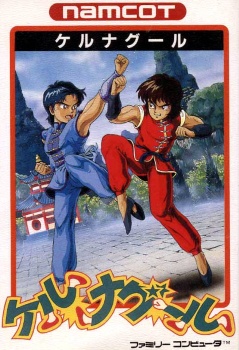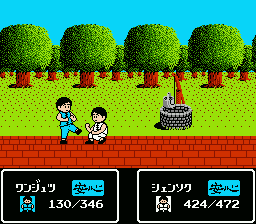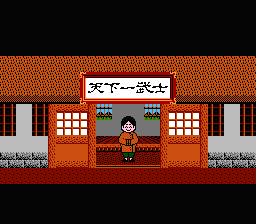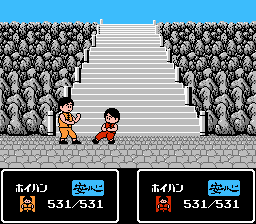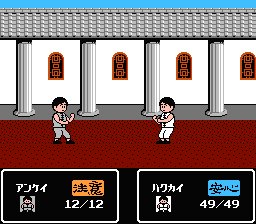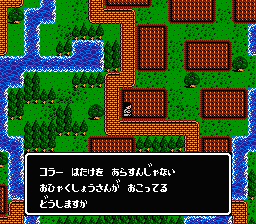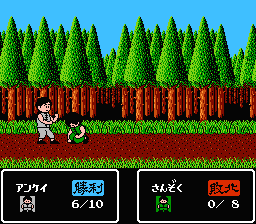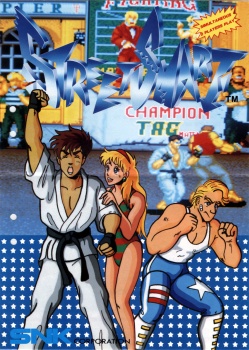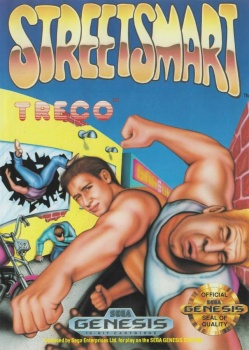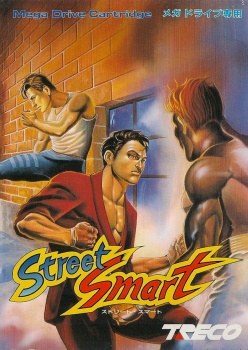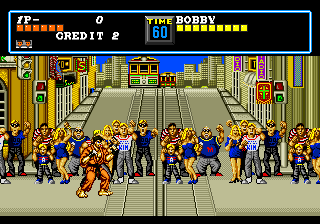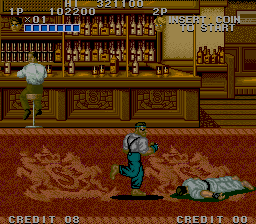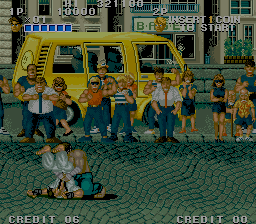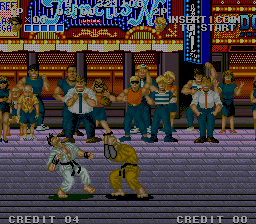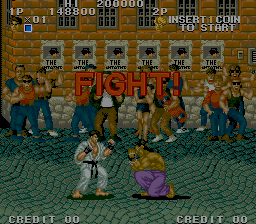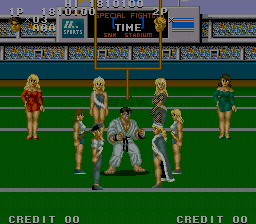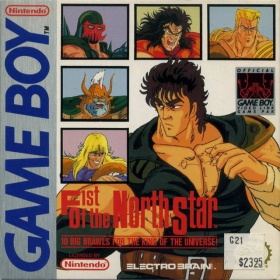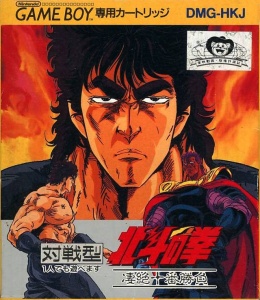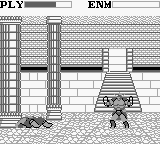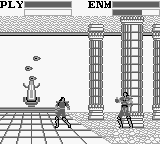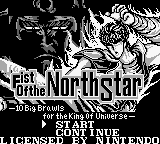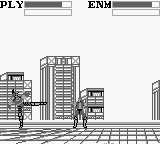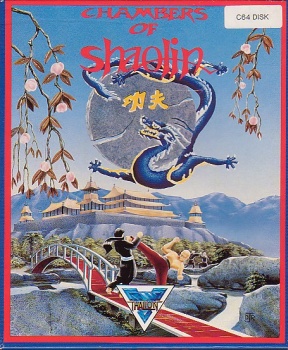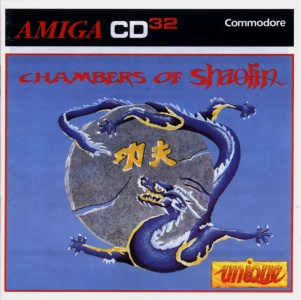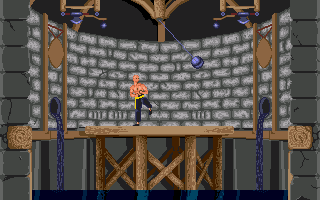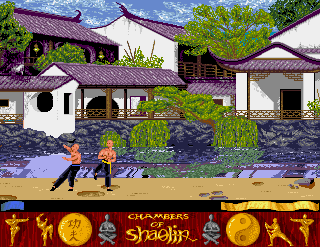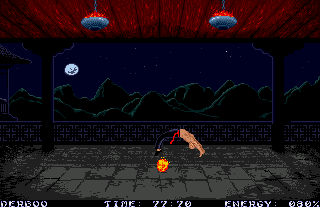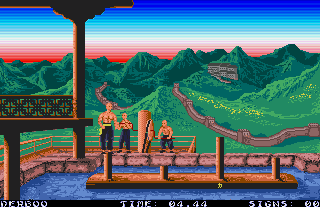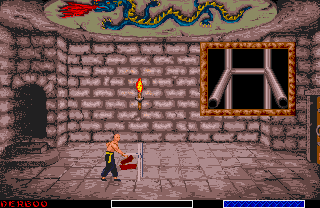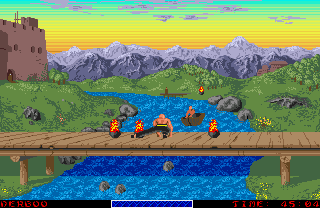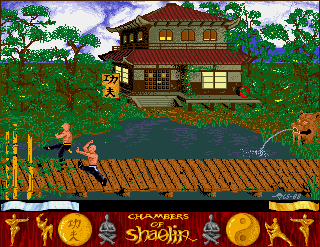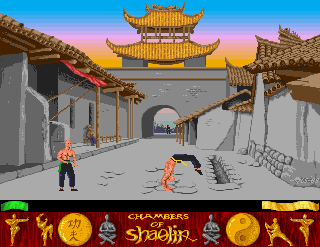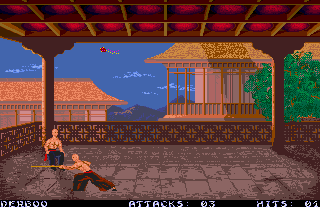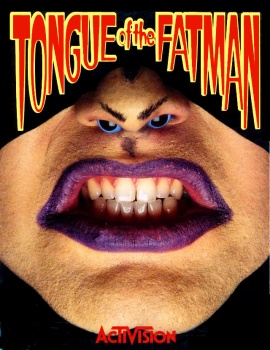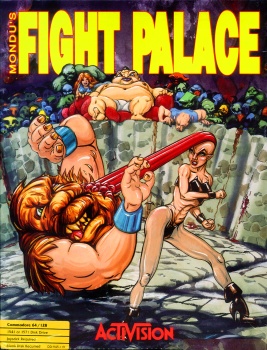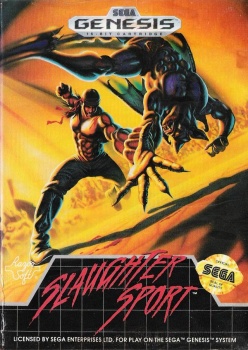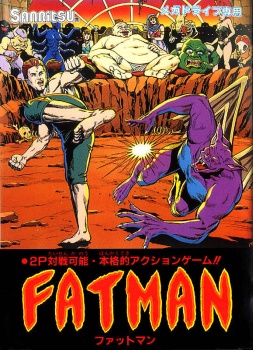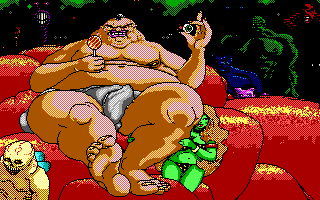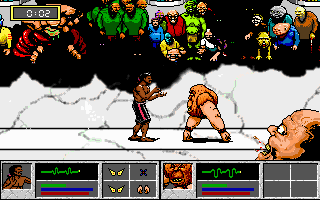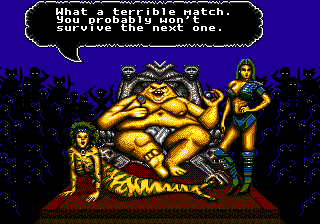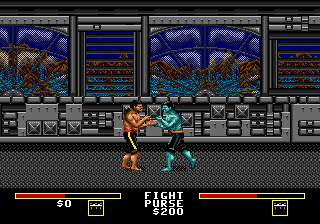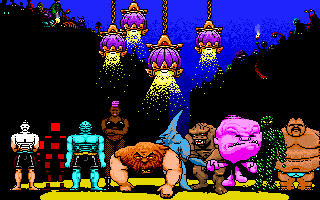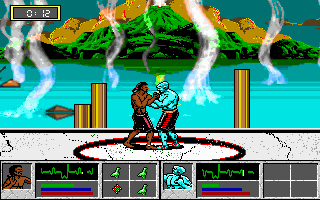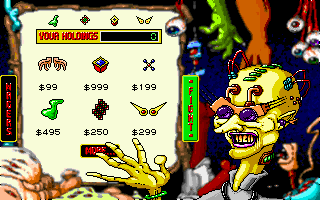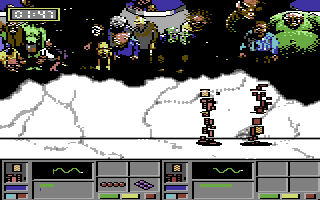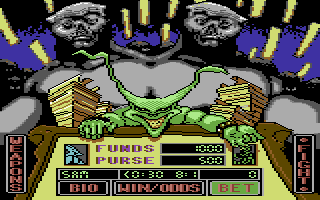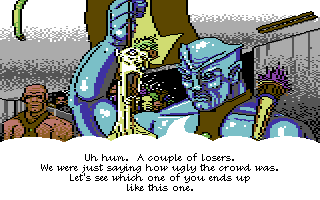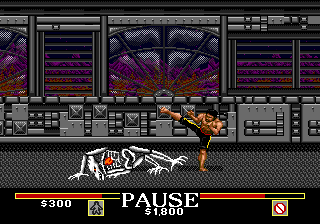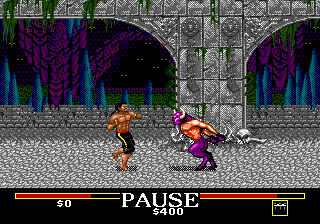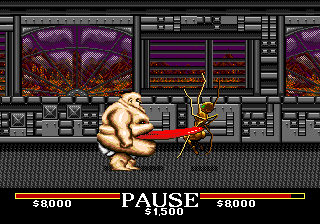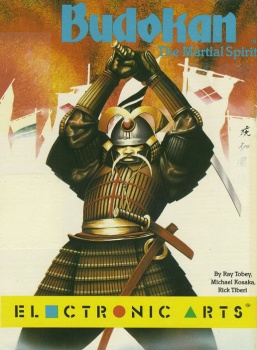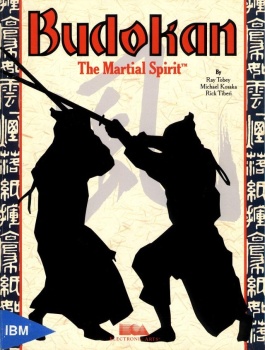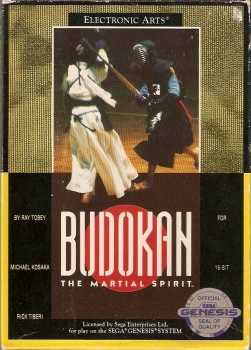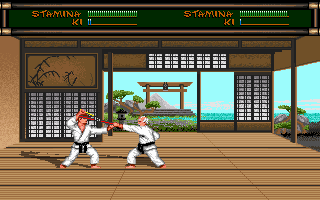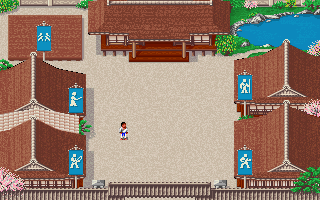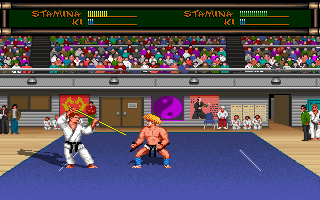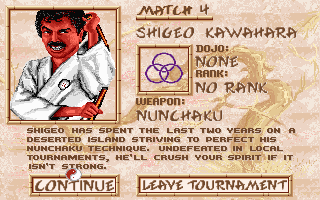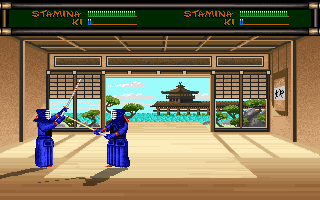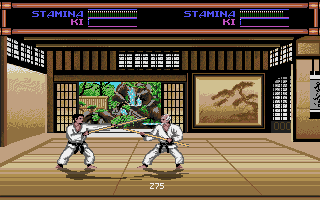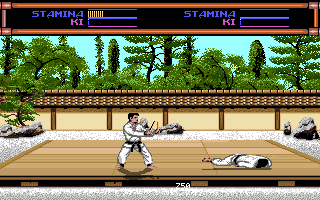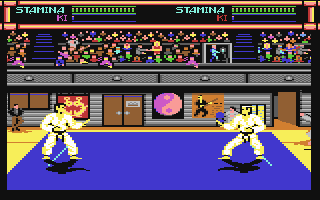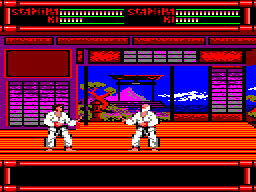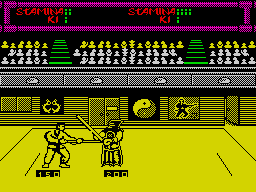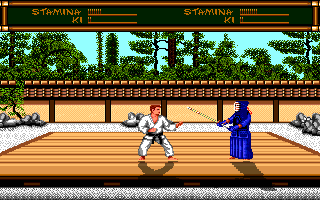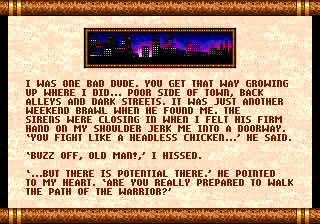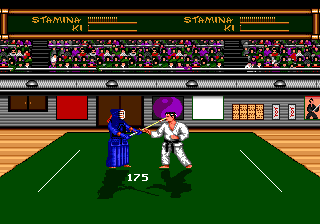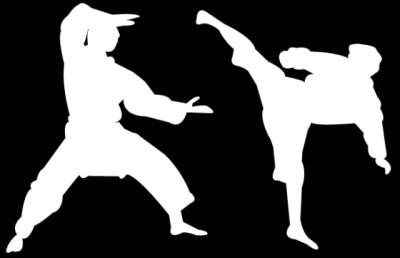
Pre-Street Fighter II Fighting Games
|
Page 1: |
Page 2: |
Page 3: |
Page 4: |
Page 5: |
|
Page 6: |
Page 7: |
Page 8: |
Page 9: |
Page 10: |
|
Page 11: |
Page 12: |
Tenkaichi Bushi: Keru Naguuru ("The Greatest Warrior on Earth: Kick Your Enemy to the Ground") is Namco's first fighting game. It has 16 playable characters, with 1 in training mode and 15 in the stand alone matches, which is an amazing selection for the time the game was released, even though they are all merely palette swaps to save memory on sprites. This kind of efficiency allows for amazing animations for a Famicom game.
The move sets are fairly limited, but acceptable, and every attack is executed with the same button, while jumping is performed with the remaining button. Differences between characters can be somewhat strange. Certain characters lack the ability to duck or jump, and others have less moves than the rest. A few characters can even block by holding up. Fights require extremely precise timing and distance control. Attack and retreat is the name of the game here. Health is measured with a number rather than the traditional health bar or notches. Different moves will reduce that number by different amounts, knocking out the character if it reaches zero.
Training mode is actually this game's equivalent of a story mode. After choosing a name for the main character from a selection of eight, the game starts on an overhead map view, which contains a series of towns and varying terrain. At first the protagonist has 10 health points and can only punch. More health points and moves can be acquired over time. There are several places where a elderly man talks to the main character, and then a fight on a background with pillars ensues. Winning these fights grants extra skills. In other buildings people challenge the hero to a fight or talk about stuff. There are also occasional random battles like in an RPG. Except, of course, they are fighting game matches.
The game has a mild "chibi" look and the animation looks great. Aside from being another fighting/RPG hybrid, there is really nothing innovative about the fighting system. As far as early fighting games go, however, it resides on the more playable end of the spectrum.
Quick Info:
|
Developer: |
|
|
Publisher: |
|
|
Genre: |
|
|
Theme: |
Tenkaichi Bushi: Keru Nagūru (Famicom)
Tenkaichi Bushi: Keru Nagūru (Famicom)
Tenkaichi Bushi: Keru Nagūru (Famicom)
Street Smart is SNK's introduction to the fighting genre. Disappointingly, it isn't very good. This game plays like a series of eight beat-em-up boss fights. However, these take quite a while to beat. There are three buttons for jumping, punches and kicks, which are once again used in combination with holding a direction to execute different moves.
All moves cause the character to move forward while executing them. This makes the gameplay extremely awkward and can cause problems when moving past the enemy while trying to attack. The character then accidentally keeps moving in that direction instead of immediately realigning with the opponent.
Street Smart is the first game in the genre where normal moves can be part of a string of combos. These combos are executed the same way as a beat-em-up, by using the opponent's hit stun to connect more than one attack in a row. The combo system is simple, but it is the first of its kind. It also was the first fighter to have co-operative play. Two players can team up to fight the game's boss characters.
Street Smart (Genesis)
The game's graphics and audio aren't spectacular, but they could be worse. The character designs are pretty horrible, but there are nice details like the "SNK Ambulance" that takes away fallen foes and a different woman to congratulate the hero/heroes after each fight. At the end of the game the hero/heroes are seen standing in a stadium with each of these hostesses congratulating them on winning the game. There is a great looking level that takes place in a bar, but otherwise the stage designs are not really noteworthy. The music isn't very good, but there is digitized speech, which is always a nice touch. There is a port for the Genesis, with the digitized speech and the SNK Ambulance removed.
Fist of the North Star: 10 Big Brawls for the King Of Universe / Hokuto no Ken: Seijetsu Juuban Shoubu - Game Boy (1989)
10 Big Brawls for the King Of Universe is the first fighting game to ever originate on a portable console, and also the first based on the Fist of the North Star/Hokuto no Ken franchise. Tragically, it is not any better than the horrible Super Famicom sequels.
The Hokuto no Ken manga/anime series follows the nomadic exploits of a martial artist named Kenshiro in a Mad Max inspired post-apocalyptic future. His secret martial arts style, Hokuto Shinken, allows him to kill an opponent with a single hit by causing them to explode. Nobody explodes in this game, though. There are a number of characters from the manga, including the hero, Kenshiro, Mr. Heart, Shin, Jagi, Uygur, Souther, Raoh, Falco, Han, Hyou and Kaioh.
There are two attack buttons for certain characters, but a few only have one button. A few characters have a fireball that is executed by holding down a specific attack button while a meter charges below the character's health meter. Releasing the button then launches the fireball. The only noteworthy gameplay elements are that many consecutive attacks can be performed while airborne, and that characters can be brought back to the ground at any time after jumping by holding down, allowing for a high level of control of jumps. After each won battle experience points to level up the character and make them more powerful. Controls are otherwise as bad as would be expected when knowing the Super Famicom follow-ups. Graphics and audio are even worse.
Even taking into account the camp appeal of the Hokuto no Ken series and bad games in general, it is difficult to get past the terrible gameplay here. There really is not a good thing to say about this game, and it merely stands as a curiosity due to its license and awful follow-ups. At least this entry proves that those games were not Street Fighter II clones.
Quick Info:
|
Developer: |
|
|
Publisher: |
|
|
Genre: |
|
|
Themes: |
Fist of the North Star (Game Boy)
Fist of the North Star (Game Boy)
Additional Screenshots
Chambers of Shaolin of course is inspired by the legendary Shaw Brothers movie The 36th Chamber of Shaolin. So why only Chambers of Shaolin? Because there are nowhere near 36 chambers in this game, and "Six of the 36 Chambers of Shaolin" doesn't quite have the same ring to it.
True to the film, which places emphasis on the training of martial arts rather than its execution in battle, Chambers of Shaolin promotes what would elsewhere be the bonus rounds to main game status. The chambers that are there range from boring to excellent: Not so great is the challenge where the player simply has to duck or jump to avoid the instructor's blows with a stick, and the Karate Champ rip-off with objects flying across the screen. The balance challenge is not very deep but fun. Here the martial arts pupil has to jump back and forth moving poles, just when they are at about to the same level, or else he falls down into the water. The plank breaking challenge is a little bit more involved than in other games: At first the player has to time a button press to stop the striking hand at the middle of the wooden planks, before mashing two buttons in quick alternations to gather strength. By far the best is the room with water flowing in, where the solution is to keep an iron ball swinging to greater and greater heights, so it smashes some blockades to contraptions that stop the water from flowing. In the final "chamber" someone throws burning balls onto a bridge, and the player has to get rid of them with swiping kicks.
Each challenge raises certain stats depending on the player's performance, which can then be saved on disk and used for the fighting mode, where four human opponents have to be beaten, before facing off against a mighty dragon. This one is very similar to the Exploding Fist formula, but has more elaborate and beautiful moves due to a more elegant discipline being covered. The controls are very smooth, but unfortunately there is one major problem: Characters are invincible for the duration of every attack, so the only chance to land a hit is during the 1-frame pause in between moves. Suffice it to say, matches take forever and rarely end in the player's favor.
Originally for Amiga and Atari ST, Chambers of Shaolin was then ported to the Commodore 64. It loses the two most boring chambers, as well as the final one on the bridge. The fighting part also takes place immediately after the training. The dragon boss is also gone, but at least the hit detection and AI are not as relentless as in the 16-bit versions. The controls are notably less responsive, though. In 1994, the game appeared on the Amiga CD32, which is identical to the regular Amiga version, aside from a control scheme optimized for multi button joypads. While the game was still considered fairly decent upon its original release, by now its mechanics of course were utterly outdated, which resulted in the CD version being utterly demolished in the reviews.
Additional Screenshots
Tongue of the Fatman / Fatman / Mondu's Fight Palace / Slaughter Sport - IBM PC, Commodore 64, Genesis (1989)
Fatman is possibly the worst fighting game ever. The game has horrid hit detection, and its almost non existent move sets are horribly boring. The the biggest problem is with the game are the controls. Getting the character to do anything is nigh impossible. The health system is so obscure, you may still lose even after figuring out an opponent's weakness and hitting them like crazy. The controls respond poorly and the physics are as awkward as could be.
There are ten different combatants from alien species, including amazons, walking sharks, pink blobs and lose arrays of hovering rectangles. The player just selects a generic member of the species and choses their name, but the model and fighting characteristics are the same as the specific opponent of that race. In between fights, upgrade items can be bought from an item store, but they're expensive and the distribution of funds has to be weighed against betting, which results in more prize money in the unlikely case of a win. After losing, the character can be resurrected for 10,000, else it's game over.
The Commodore 64 version was renamed to Mondu's Fight Palace, but it is mostly the same deal as the IBM PC aside from downgraded graphics and the introduction of a two-player mode.
The Genesis port was retitled Slaughter Sport in America and Fatman in Japan. Slaughter Sport is actually not all that terrible. The hit detection is still bad and there's significant input delay with some attacks, but it's changed to a standard health system and it's possible to learn to exploit the various' enemies weaknesses. In that way it works similar to Art of Fighting, only much more awkward and limited to a handful of moves. Winning the later fights becomes insanely difficult as the enemies get meaner and meaner, though. The shop is still there, although a lot of items have been excised for a more concise selection, which may turn around the opponent's controls, make them unable to attack or jump, or turn your own fighter invisible for a while. But most of the prize money goes into recharging health and attack power, which are carried over from fight to fight.
The Genesis version loses most of the comic book style intro graphics and replaces several of the rather boring alien species with more interesting opponents, like a farting gargoyle, a monstrous skeleton with a pumping heart in its ribcage and a ghastly spider woman. Aside from the Fatman Mondu, there are eight very different combatants. Each of them has a stronger, differently colored twin, making for a total of 17 matches. In single player mode, the only available character is the human Rex, in versus mode both players can freely choose from the entire bestiary.
Quick Info:
|
Developer: |
|
|
Publisher: |
|
|
Designer: |
|
|
Genre: |
|
|
Themes: |
Tongue of the Fatman (IBM PC)
Tongue of the Fatman (IBM PC)
Slaughter Sport (Genesis)
Slaughter Sport (Genesis)
Budokan: The Martial Spirit - IBM PC, Amiga, Commodore 64, Amstrad CPC, ZX Spectrum, MSX (1989/1990)
Budokan is a multi-event competitive martial arts themed game. After choosing one of four events - Karate, Bo fighting, Kendo, and Nunchuck fighting - one can either practice moves to get a feel for the controls, or begin competing. There is also a tournament where any of these four events can be competed in. Moves are executed with a simple button and direction, but controls are not as easily responsive as most early fighters. Because of the control issues, it is a rather difficult game to play. Points are rewarded for each hit and the competitor with the most points at the end is declared the winner. There is an endurance meter that goes down each time an attack is executed. The higher meter is, the more points are rewarded for each attack. This system forces the player to fight methodically in order to get the highest possible points.
The IBM PC, Amiga and Genesis versions are pretty much identical, except for mild visual differences. Stay away from the Commodore 64 and ZX Spectrum ports. On top of looking horrible, they also control awfully. The Amstrad CPC port is pretty faithful to the 16-bit versions, except it looks horrible.
While the original game is a straight sports competition deaal, the Genesis version was given a plot. It's about a street fighting thug being offered to compete in a martial arts tournament by a old martial arts master. It starts with something like "I was a bad dude. You get that way growing up where I did." Needless to say, it's pretty lame.
Quick Info:
|
Developer: |
|
|
Publisher: |
|
|
Designer: |
|
|
Genre: |
Budokan: The Martial Spirit (IBM PC)
Additional Screenshots
|
Page 1: |
Page 2: |
Page 3: |
Page 4: |
Page 5: |
|
Page 6: |
Page 7: |
Page 8: |
Page 9: |
Page 10: |
|
Page 11: |
Page 12: |
